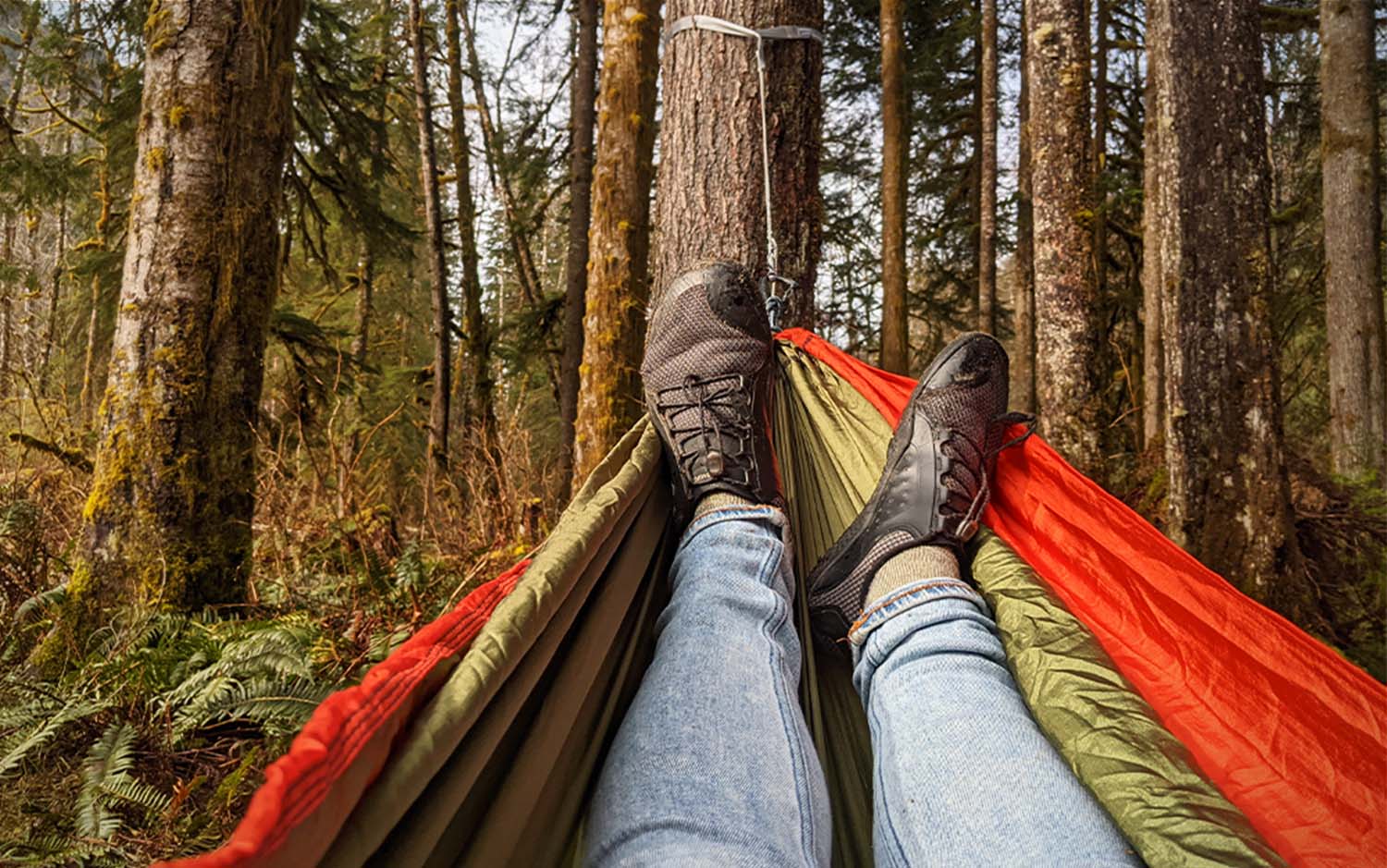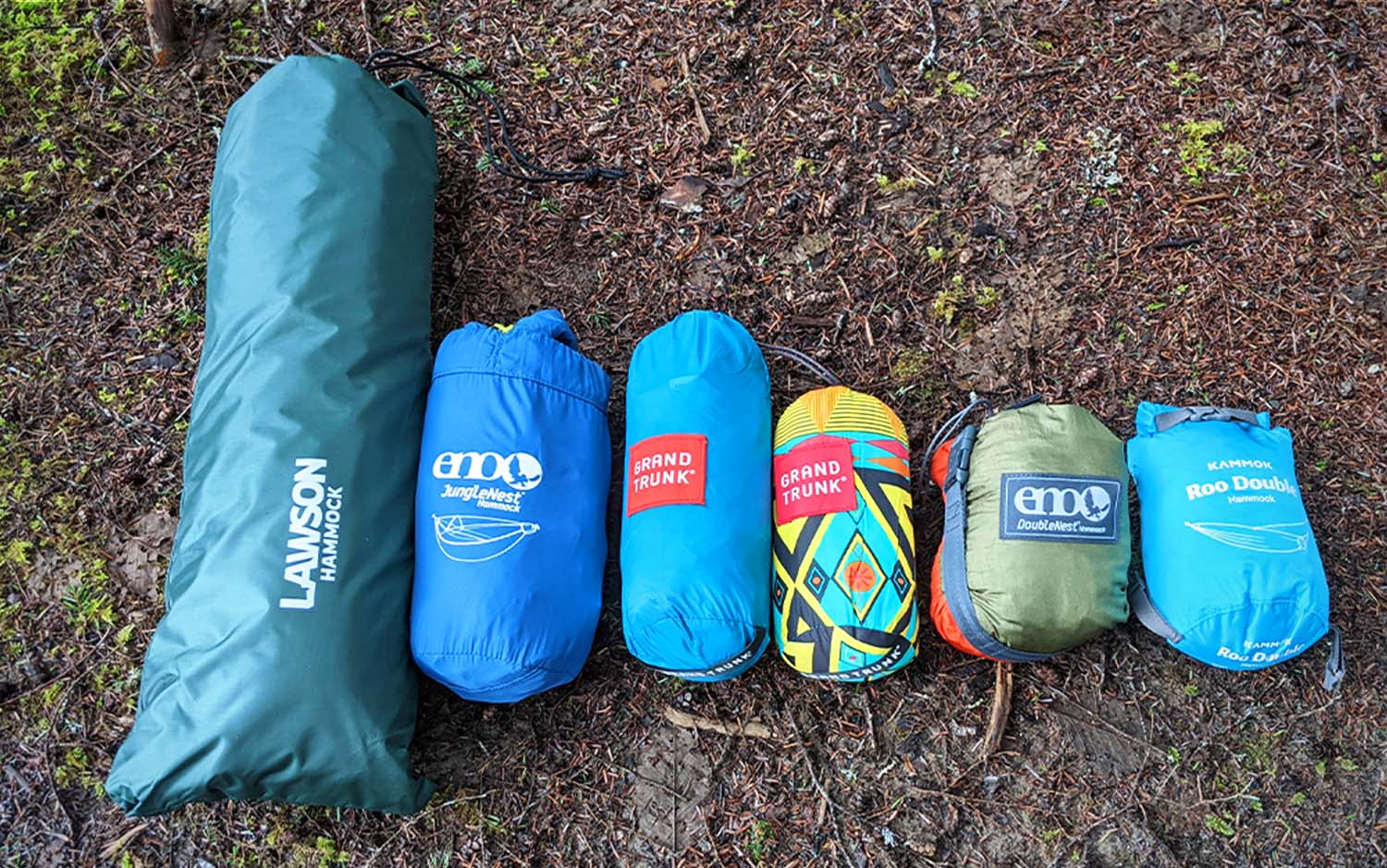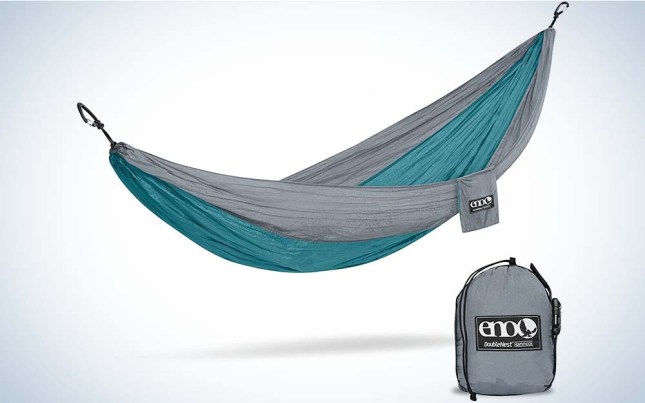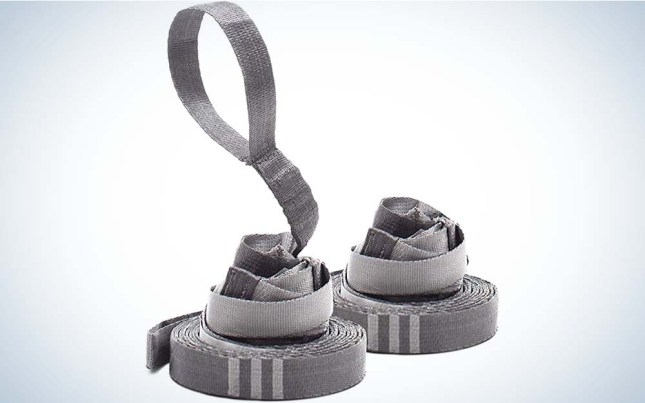We may earn revenue from the products available on this page and participate in affiliate programs. Learn More ›
If you’ve ever slogged an extra hour or two in the evening in search of that elusive flat spot in a dense forest to pitch your tent, then you understand the appeal of a camping hammock. Simply find two sturdy trees, no matter the slope or rockiness of the ground, and you’re good to go. But are they really that comfortable? What if your knot-tying skills are a bit rusty (or non-existent)? And just how easy are they to fall out of?
For this review, I tested six hammocks available today to find the best one for beginners. However, two of them were too heavy and complicated to assemble to make the final cut or lacked in the areas where they were supposed to excel. So, I arrived at four of the best camping hammocks to take on your next outdoor adventure.
- Best Overall: ENO DoubleNest
- Best Lightweight: Kammok Roo Single
- Best for Bug Protection: ENO JungleNest
- Best Suspension System: Kammock Python 10
How I Tested the Best Camping Hammocks
While I’ve seen any number of backpacking hammocks on the trail, my personal experience with them prior to this test was limited—so if you are a camping hammock novice wondering if you can get the hang of this, I’m here to tell you that you absolutely can.
For this test, I took these hammocks off-grid to see how easy they were to set up and how comfortable they were, just by following (for the most part) the provided manufacturer instructions. I further evaluated the best camping hammocks on price, comfort, features, and security, including whether I trusted that the hang was stable enough to relax. Then I tested the camping hammocks with a combination of different suspension straps on a series of trees with widely different diameters to determine which hammock was the easiest to use and whether the straps were worth purchasing if you already have an appropriate rope or cord to use at home.

Best Camping Hammocks: Reviews & Recommendations
Best Overall: ENO DoubleNest
Key Features
- Weight: 19 ounces
- Weight Limit: 400 pounds
- Dimensions: 9 feet, 6 inches x 6 feet, 4 inches
- Suspension straps not included
- Material: 70D nylon
Pros
- Durable material
- Easy setup
Cons
- Comparatively low weight limit for a two-person hammock
ENO’s DoubleNest is easily the most straightforward camping hammock to hang. Like other models I tested, the instructions were minimal and easily fitted on a hangtag tucked inside the stuff pouch, yet they were also specific enough—including details about diagonal lay and the correct angle of the suspension system—to provide this first-time user with enough information to get the most out of the hammock.

The fabric of the DoubleNest is thicker than the others I tested, and that durability increased my confidence in the hammock’s support. Once I sat down and swung my legs inside, I was surprised at how comfortable and secure I felt. The Doublenest had the smallest profile of the best camping hammock picks, and it would easily fit into a daypack for someone looking to lounge and enjoy the view at their destination.
Best Lightweight: Kammok Roo Single
Key Features
- Weight: 11.4 ounces
- Weight Limit: 500 pounds
- Dimensions: 8 feet, 4 inches x 4 feet, 2 inches
- Suspension straps not included
- Material: 40D ripstop nylon
Pros
- 100 percent recycled materials
- Comfortable
- Straightforward to set up
Cons
- Felt less durable than others in test
Like any lightweight gear, there are some pros and cons to the Roo Single. I liked that it felt comfortable to the skin and used recycled materials (the only brand that did so in my test). The thinner fabric, compared to the ENO DoubleNest, also cut down on the overall weight of the camping hammock, which is helpful if you’re trying to keep your pack weight down. The material did feel less substantial than the best overall pick, but there were no issues during the test. While the instructions provided by Kammok were not as thorough as the ENO, setup was fast—just a couple of minutes and it was time to lounge.
Best for Bug Protection: ENO JungleNest
Key Features
- Weight: 20 ounces
- Weight Limit: 300 pounds
- Dimensions: 10 feet x 4 feet, 10 inches
- Suspension straps not included
- Material: 40D nylon; mesh
Pros
- Easy setup
- Lightweight, effective mesh
- Convenient pockets
Cons
- Only available in single option
I started this test in early spring, which meant that the first of the year’s mosquitoes were starting to waft around sleepily when the sun broke through the clouds. Fortunately, the setup of the JungleNest was just as simple as the DoubleNest, with the addition of a simple spacer bar above where the user’s head goes. From the outside, you’d be forgiven for wondering if all the mesh feels claustrophobic, but the inside of the JungleNest feels open and breezy, with plenty of headspace (along with some handy pockets for stashing your gear).

The JungleNest is also fully convertible, and the mesh zips off easily so you can stash it into a pocket at the foot of the hammock when not in use. This is a great choice for someone who wants to get more out of their outdoor experience in a buggy part of the country.
Best Suspension System: Kammok Python 10 Straps
Key Features
- Weight: 8.2 ounces
- Width: 1.5 inches
- Combined Length: 20 feet, 5 inches
- Material: Polyester
- Weight Limit: 500 pounds
- Connection Points: 20
Pros
- 1.5-inch width does less damage to trees than other models
- Durable 500-pound weight limit
Cons
- Difficult to fine tune the angle of the hang once the hammock is set up
- Difficult to adjust webbing
In accordance with LNT standards, this suspension strap is thickest where it loops around the tree (to minimize damage to the tree itself), but narrows where it stretches out to connect to the camping hammock, which minimizes extra weight in your pack. And with a 500-pound weight limit, this hammock isn’t going anywhere. This model didn’t provide as much opportunity to fine tune the angle of the hang as others I tested, but it was more than enough to relax at camp or on the go.

Things to Consider Before Buying a Camping Hammock
Lounging vs. Sleep System
There are a number of lightweight models on the market that are perfect for napping by a lake on a sunny day or kicking back at the campsite. But creating a full sleep system—one that can withstand rain, wind, cold, and the dreaded mosquito—is another beast entirely that’s typically integrated with a built-in bug net, rainfly, and underquilt. If you’re new to camping hammocks, start with a simpler model before diving into the full setup.
Terrain
Camping hammocks are most popular in areas with dense tree cover, like the Appalachians. They’re not an ideal option for individuals recreating in desert environments or where there are an unusual number of dead trees, which aren’t safe for hammocking. If you plan to use your camping hammock at a campground or national or state park, check local regulations as there are sometimes limitations on when and how they can be used to minimize potential damage to trees.

Material
Camping hammocks are typically made out of nylon that’s 40D (or denier) to a relatively robust 70D. Several are also woven in a square pattern (called ripstop) that further increases durability. At either end of the hammock, a short rope is slung through the bunched-up fabric and then looped to hook on a carabiner (typically aluminum).
Suspension System
Good news: there’s no rope tying required to hang a camping hammock if you use a suspension system. Even better, they also do a better job than rope of protecting trees from unnecessary damage. To minimize the amount of webbing that cuts into tree bark, Leave No Trace principles recommend using straps made of webbing at least 1-1.5-inches wide.
FAQs
Camping hammock enthusiasts are quick to claim that they are more comfortable sleeping in the air than sleeping on a pad on the ground. So, yes, they can be comfortable, but this requires some trial and error to figure out what angle, tautness, diagonal lay, and extra guylines are needed for a comfortable sleeping position. Start with short overnight trips before committing to a thru-hike with a camping hammock.
Camping hammocks range from $50 for a simple single-person hammock to $200 for one with a bug net and rainfly. Suspension systems are typically sold separately and cost in the range of $30 to $40.
Yes, most manufacturers include a weight limit, so be sure to check before you purchase a hammock. There’s also a weight limit associated with the suspension straps, sometimes noted for a single strap and sometimes for a pair.
Why Trust Outdoor Life?
Since 1898, OL has been a leading authority in testing and reviewing hunting gear, fishing tackle, guns and shooting equipment, and much more. We have more than a century-long history of evaluating products, and we’re now bringing that expertise to online reviews. Our editors are experienced outdoorsmen and women, and most importantly, we’re trained journalists. We prioritize field testing and objective data when reviewing products. We conduct interviews with gear manufacturers and engineers as well as outdoor experts so that our readers have an understanding of how and why a product works—or doesn’t.
Advertising does not influence our gear reviews and it never will. While we always focus our coverage on standout products—because we want our readers to be aware of the latest and greatest gear—we also cover the flaws and quirks of any given product.
Final Thoughts
The best camping hammocks can be a relaxing addition to your outdoor adventure kit, whether you plan to use it for an afternoon at your basecamp or implement one as your sleep system. Fortunately, even the best camping hammocks are inexpensive enough that backpackers can experiment with them before replacing their traditional tent, sleeping pad, and sleeping bag setup. Regardless, I recommend picking one up as a complement for any low-key long weekend trip.
- Best Overall: ENO DoubleNest
- Best Lightweight: Kammok Roo Single
- Best for Bug Protection: ENO JungleNest
- Best Suspension System: Kammock Python 10







